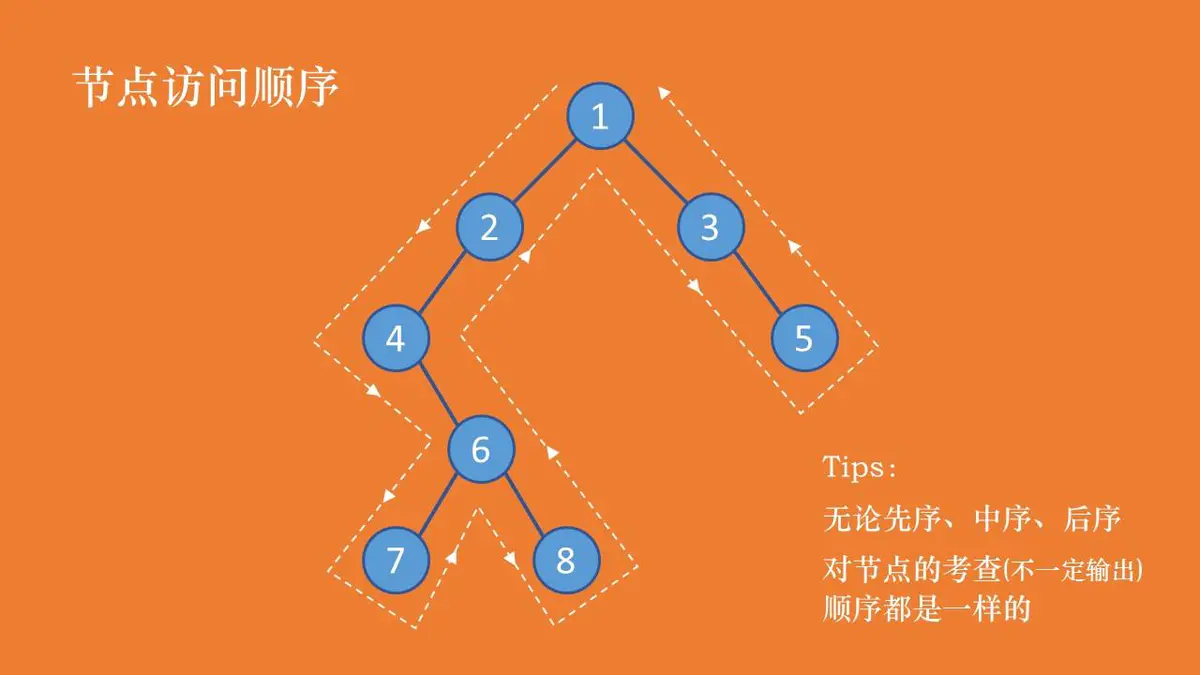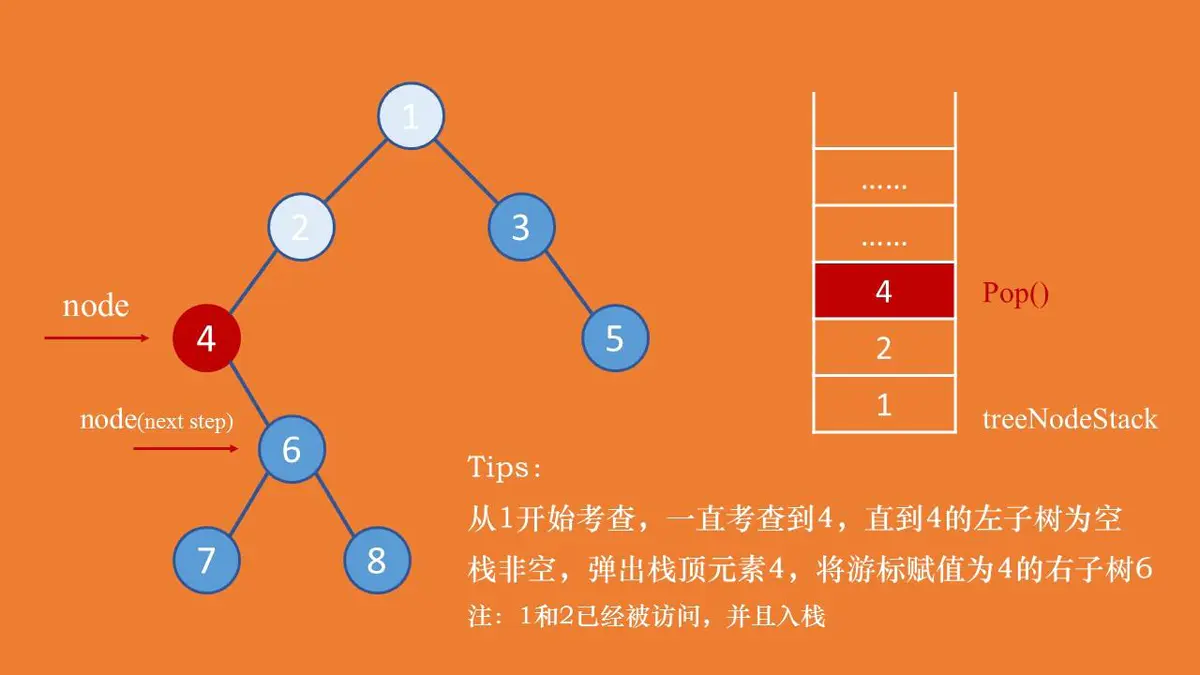二叉树节点结构
1
2
3
4
5
6
7
8
| public class TreeNode{
int val;
TreeNode left;
TreeNode right;
TreeNode(int x){
this.val = x;
}
}
|
前序遍历
前序遍历:根结点 —> 左子树 —> 右子树 (根节点在 前中后 那个位置 就叫什么遍历)

前序遍历:1 2 4 6 7 8 3 5
题目
144.二叉树的前序遍历
递归算法
1
2
3
4
5
6
7
8
9
10
11
12
13
| class Solution {
List<Integer> res = new ArrayList<Integer>();
public List<Integer> preorderTraversal(TreeNode root){
if (root == null) return res;
res.add(root.val);
preorderTraversal(root.left);
preorderTraversal(root.right);
}
return res;
}
|
迭代法

1
2
3
4
5
6
7
8
9
10
11
12
13
14
15
16
17
18
| class Solution {
public List<Integer> preorderTraversal(TreeNode root) {
List<Integer> res = new ArrayList<Integer>();
Stack<TreeNode> stack = new Stack<TreeNode>();
while(root!=null || !stack.empty()){
while(root!=null){
res.add(root.val);
stack.push(root);
root = root.left;
}
root = stack.pop();
root = root.right;
}
return res;
}
}
|
中序遍历
中序遍历:左子树—> 根结点 —> 右子树 (根节点在 前中后 那个位置 就叫什么遍历)

中序遍历 :4 7 6 8 2 1 3 5
题目
94.二叉树的中序遍历
递归算法
1
2
3
4
5
6
7
8
9
10
| class Solution {
List<Integer> res = new ArrayList<Integer>();
public List<Integer> inorderTraversal(TreeNode root) {
if(root == null) return res;
inorderTraversal(root.left);
res.add(root.val);
inorderTraversal(root.right);
return res;
}
}
|
迭代法

1
2
3
4
5
6
7
8
9
10
11
12
13
14
15
16
17
| class Solution {
public List<Integer> preorderTraversal(TreeNode root) {
List<Integer> res = new ArrayList<Integer>();
Stack<TreeNode> stack = new Stack<TreeNode>();
while(root!=null || !stack.empty()){
while(root!=null){
stack.push(root);
root = root.left;
}
root = stack.pop();
res.add(root.val);
root = root.right;
}
return res;
}
}
|
后续遍历
后序遍历: 左子树 —> 右子树 —>根结点 (根节点在 前中后 那个位置 就叫什么遍历)

后序遍历:7 8 6 4 2 5 3 1
题目
145.二叉树的后序遍历
递归算法
后序遍历:左子树 —> 右子树 —> 根结点(根节点在 前中后 那个位置 就叫什么遍历)
1
2
3
4
5
6
7
8
9
10
| class Solution {
List<Integer> res = new ArrayList<>();
public List<Integer> postorderTraversal(TreeNode root) {
if (root == null) return res;
postorderTraversal(root.left);
postorderTraversal(root.right);
res.add(root.val);
return res;
}
}
|
迭代法
1
2
3
4
5
6
7
8
9
10
11
12
13
14
15
16
17
18
19
20
21
22
23
| class Solution {
public List<Integer> postorderTraversal(TreeNode root) {
List<Integer> res = new ArrayList<Integer>();
Stack<TreeNode> stack = new Stack<>();
TreeNode pre = null;
while(root!=null || !stack.empty()){
while(root!=null){
stack.push(root);
root = root.left;
}
root = stack.peek();
if(root.right==null || root.right==pre){
res.add(root.val);
pre = root;
stack.pop();
root = null;
}else{
root = root.right;
}
}
return res;
}
}
|
第二种解法
1
2
3
4
5
6
7
8
9
10
11
12
13
14
15
16
17
18
19
20
|
class Solution {
public List<Integer> postorderTraversal(TreeNode root) {
LinkedList res = new LinkedList();
Stack<TreeNode> stack = new Stack<>();
TreeNode pre = null;
while(root!=null || !stack.empty()){
while(root!=null){
res.addFirst(root.val);
stack.push(root);
root = root.right;
}
root = stack.pop();
root = root.left;
}
return res;
}
}
|









